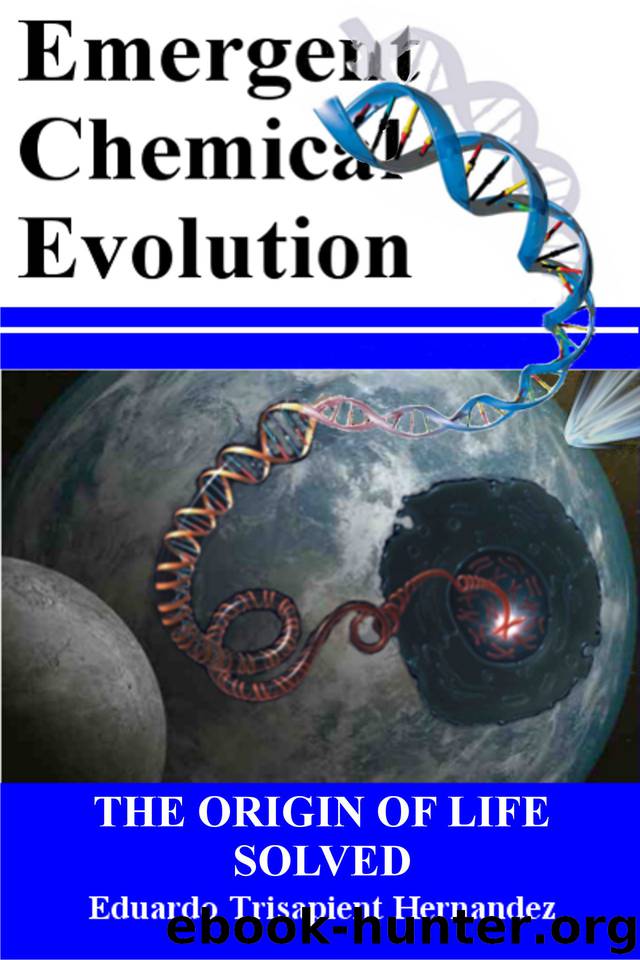Emergent Chemical Evolution: The Origin of Life Solved by Hernandez Eduardo

Author:Hernandez, Eduardo [Hernandez, Eduardo]
Language: eng
Format: epub
Published: 2018-02-11T16:00:00+00:00
Figure 9. (A) Homology-based model (as calculated by the Robetta server) of NRMT2 molecule (yellow) having the same overall fold as NRMT1 crystal structure (green; PDB code 2EX4). The position of the S -adenosylhomocysteine molecule in the NRMT1 crystal structure is shown in blue. The N-terminal 60-amino-acid domain of NRMT2, which is not present in NRMT1, is modelled as two helices. (B) Critical catalytic residues in NRMT2 (orange font) occupy the same spatial positions as in the NRMT1 crystal structure (black font). (C) Conserved aromatic resides in NRMT1 and NRMT2 form a chromodomain-like arrangement of aromatic residues and may be responsible for binding methylated substrates and products (J. Petkowski et all 2013 )
find that all of the important proteins in Life today have this structure. This also explains the large number of amino acid differences in the sequences of homolog proteins. Since large portions of the protein are not part of the reactive site they are free to take on any sequence that still makes an alpha-helix. This is why we see up to a 40% difference in the amino acid sequence of homolog proteins but they can still carry out the same exact chemical reaction; this also applies to beta-sheet conformations, too.
The Trisapient Homolog Process (THP) would have undoubtedly produced an unaccountable amount of different small proteins. And given the nature of proteins, with their propensity for forming ionic bonds and van der wall forces, they would have undoubtedly been interacting with each other. Interacting in ways that would have caused the small proteins to unite with each other and make larger proteins. Much like we see in modern cells today. In modern cells, they encode in their DNA the information for making several small individual proteins. These small proteins would then unite to make a larger protein. All that work just to perform one specific chemical reaction. Individually, these small proteins cannot perform any chemical reactions until they unite with their counterparts creating a collective reactive center. I do not see why we would expect it to be any different when THP was in full force back then. Especially when, for over 600 million years, meteors and asteroids impacted the amino acid laden oceans, which modern experiments confirm, would have made trillions of polypeptides with every impact.
The most important chemical reaction, for Emergent Chemical Evolution (ECE), that would have been peformed by small proteins uniting is the catalysis of the first step in the pyrimidine biosynthesis by the enzyme Aspartate Carbamoyltransferase (ATCase).This is also the first step in the synthesis of RNA. ATCase, in Escheria coli, is a 12 unit protein complex. It is made of 12 small individually encoded proteins that are bound together by ionic and hydrophobic interactions between their amino acid residues. Meaning that these 12 smaller proteins self assemble into a larger enzyme. Six of the subunits are catalytic who together make the reactive pocket using only 12 amino acids that perform the catalytic reaction (I came up with my beach ball example long
Download
This site does not store any files on its server. We only index and link to content provided by other sites. Please contact the content providers to delete copyright contents if any and email us, we'll remove relevant links or contents immediately.
| Fossils | Game Theory |
| Genetics | Molecular Biology |
| Organic | Paleontology |
Sapiens: A Brief History of Humankind by Yuval Noah Harari(13053)
Sapiens by Yuval Noah Harari(4537)
Homo Deus: A Brief History of Tomorrow by Yuval Noah Harari(4279)
Pale Blue Dot by Carl Sagan(4001)
Origin Story: A Big History of Everything by David Christian(3139)
Livewired by David Eagleman(3122)
Brief Answers to the Big Questions by Stephen Hawking(2878)
Inferior by Angela Saini(2831)
Origin Story by David Christian(2683)
The Evolution of Beauty by Richard O. Prum(2553)
Signature in the Cell: DNA and the Evidence for Intelligent Design by Stephen C. Meyer(2501)
The Gene: An Intimate History by Siddhartha Mukherjee(2491)
Aliens by Jim Al-Khalili(2382)
How The Mind Works by Steven Pinker(2213)
Sex at Dawn: The Prehistoric Origins of Modern Sexuality by Ryan Christopher(2150)
From Bacteria to Bach and Back by Daniel C. Dennett(2148)
A Short History of Nearly Everything by Bryson Bill(2135)
Endless Forms Most Beautiful by Sean B. Carroll(2083)
Who We Are and How We Got Here by David Reich(2059)
